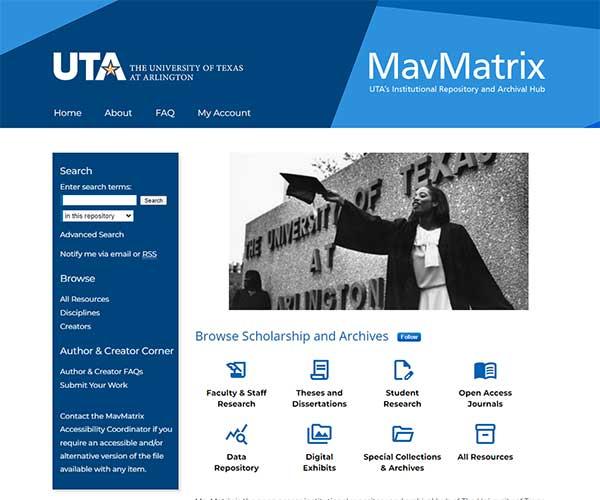
by Library News


by Library News
UTA Libraries is launching a new online repository and archival hub, MavMatrix, that will aid anyone with an internet connection in their quest for information and UTA researchers to have their works openly shared for broad public access.
On April 15, UTA Libraries is sharing a soft launch of MavMatrix with the UTA community. There will be a full launch to coincide with the beginning of the fall semester.
Leah McCurdy, Director of Open Partnerships and Services, stated that MavMatrix replaces seven previously independent platforms to create a centralized online warehouse for research outcomes and archival materials that bring people together globally.
“When we realized we had outgrown the slate of independent platforms, we decided to streamline the different repository and online access services we offer,” McCurdy said. "We focused on finding a solution that also offers customizability, to ensure that our platform is as accessible as possible, and that offers a large set of metrics to support researchers and the UTA community in our R1 emergence."
MavMatrix is a highly discoverable online digital platform that allows users to access research outcomes and publish items openly. Research outcomes include items like faculty and staff publications, theses and dissertations, and projects completed by undergraduate students in courses.
Any UTA researcher, from tenured faculty to undergraduate students, has the opportunity to publish their open-access work through the institutional repository on MavMatrix.
Another component of MavMatrix is that it will be the new home for digitized content from Special Collections. More than 120,000 items from collections like the Fort Worth Star-Telegram will eventually be migrated into MavMatrix.
Kera Newby, Director of Special Collections, stated that MavMatrix expands the Libraries’ offerings to the public.
"The most exciting part is MavMatrix's ability to present digitized materials in almost any format. If we want to digitize a diary, turn it into a PDF and make it available, we can put it up as a PDF," Newby said. "If we are digitizing oral histories, we can put them up as videos and transcriptions. It also supports classic formats like digitized photographs as JPGs."
Newby stated that the site allows Special Collections to bring digitized materials into current research by UTA faculty and students. She noted that MavMatrix will become a one-stop shop for research, including primary source research.
"MavMatrix is part of a large, interconnected platform called the Digital Commons that allows researchers to look up specific topics and find other institutions that have research on the same topic," Newby said. "So, if a UTA student researches something, they can find similar materials at another university. Students doing research at other universities will be able to find similar items of interest here at UTA. It helps draw people to our platform and lets them know what we have here."
At UTA Libraries, we look forward to bringing this service to our community, to benefit the public through global sharing of research outcomes and primary sources, and to provide another resource in the higher education journey of every student at UTA.
We encourage you to visit the MavMatrix website to explore the collected knowledge and learn about the past.
Add new comment